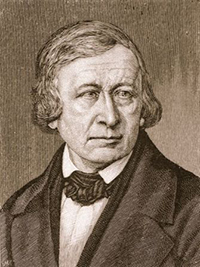
Many readers all over the world know collections of fairy tales by Brothers Grimm. However, some book worms are not aware of them separately. One of the famous brothers was Wilhelm Carl Grimm. Wilhelm was a German philologist and storyteller, the younger brother of Jacob Grimm.
Wilhelm Grimm was born on February 24, 1786, in Hanau, Germany, to the family of a lawyer. Together with his brother Jacob he was a member of the circle of Heidelberg romantics, who aimed to revive public and scientific interest in national roots and folklore. From an early age, Jakob and Wilhelm Grimm had a close bond of friendship that lasted throughout their lives.
After graduating from the Kassel Lyceum, Wilhelm, being confident that he would become a lawyer had followed his brother to the University of Marburg. However, his natural inclinations led him to philology and the study of the German people, which became the work of his whole life. Having received the post of secretary in the Kassel library in 1814, he devoted more time and energy to the knowledge of German and foreign literature.
This period of his life also includes fairy tales, the authorship of which was divided in half by the brothers, signing the work of the “Brothers Grimm.” In 1818, the brothers' scientific paths diverged, Jacob devoted himself exclusively to philological studies of Germanic dialects, and based on these studies he built his most important works “German Grammar,” 1819, “German Legal Antiquities,” 1828, and “German Mythology,” 1835. After the death of the director of the Kassel Library and the refusal of the management to transfer this position to Jacob Grimm, the brothers, offended by the injustice, leave for Gottingham, where both get a job at the university and the opportunity to continue their studies. He forces the scholars to leave Göttingham within three days, which they did, returning to Kassel, where Wilhelm took a job as secretary of the Hesse Landgrave Library. In 1825, Wilhelm Grimm married Henrietta Dorothea Wild, and in 1828 they had a son, Hermann, later a famous literary historian, professor at the University of Berlin, and co-founder of the Goethe Society.
A few years later, the brothers Grimm returned to the professorship, but already at the University of Berlin at the request of the newly ascended throne, Frederick William IV. Accepting the offer, Jacob and Wilhelm began work on the German Dictionary, which became their posthumous work.
Wilhelm Grimm died on December 16, 1859, his older brother survived him by four years, before his death he wished to look at the photograph of Wilhelm for the last time. World-famous storytellers are buried nearby at St. Matthew's Cemetery in Berlin.
Wilhelm and his brother left a trail in the history of fairy tales. The thing is that the Brothers Grimm were more scientists than writers and tried to preserve fairy tales in their original form. The content of such tales as Rapunzel, The Tale of the Frog King or Iron Henry, Cinderella, Little Red Riding Hood, Sleeping Beauty or Snow White has changed significantly over the years, thanks in large part to Wilhelm Grimm, who removed the frivolous details and rewrote folk tales in a more literary language. The second edition prepared by Wilhelm was significantly different from the first. Later, the scientist continued the literary editing of the collection. Wilhelm Grimm was eminently gifted with the ability to subtly recognize and investigate those modifications that occur in the same poetic motif during his wanderings from people to people. In the notes to fairy tales, researchers cited numerous parallels from the folklore of European and even Eastern peoples.
Summing up, we can say with confidence that Wilhelm Grimm was the main figure in the creation of a collection of fairy tales and a commentary to them, which later became a separate book. He became the best researcher of his time in the field of literary history. And he deserved the acquired fame.
Alfiya Kurmanaliyeva, librarian of the International Book Departmnet

